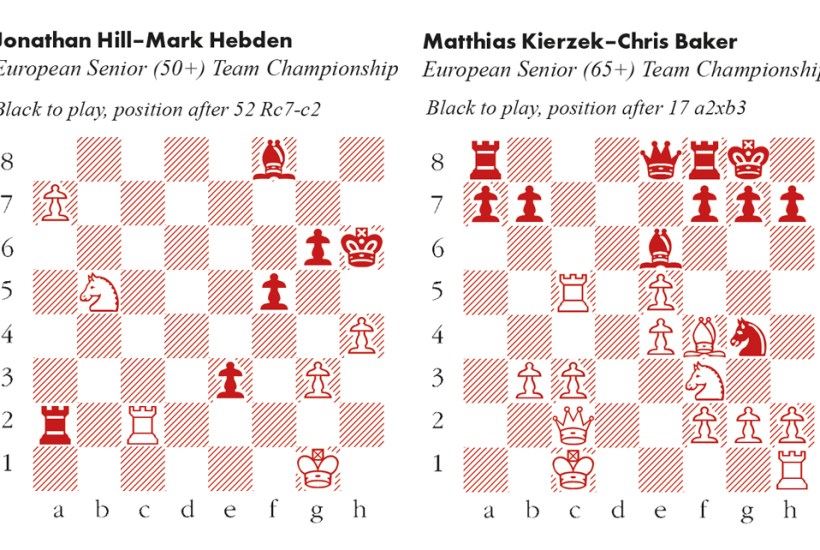England teams brought home a raft of medals from the European Senior Teams Championship, held last month in Swidnica, Poland. England’s first team were top seeds in the over-50s event, with an all-grandmaster lineup (Mark Hebden, John Emms, Keith Arkell, Glenn Flear and Chris Ward). They faced a serious challenge from Slovakia, whom they defeated in the final round by 2.5-1.5. Mark Hebden was the standout performer, winning the individual gold medal on top board with a 7.5/8 score. His game against Jonathan Hill, from England’s third team, had a neat finish.
Jonathan Hill–Mark Hebden
European Senior (50+) Team Championship
In the diagram position, capturing the rook on Rc2 would allow the a7 pawn to promote. Instead, Hebden sowed confusion with 52… e2. After 53 Rxe2 Ra1+ 54 Kg2 Bc5 secures a draw since the a7-pawn drops off, while 53 Rxa2 e1=Q+ 54 Kh2 f4! yields at least a draw by perpetual check. The move played in the game is a winning attempt which backfires. 53 Kf2 Rxc2 54 a8=Q Bc5+ 55 Kf3 Evidently, White was counting on the fact that 55…e1=Q 56 Qh8 is mate. But Hebden has one final ace to play. e1=N+ 56 Kf4 Nd3+ 57 Kf3 Rf2 mate
England also began the over-65s event as top seeds, led by John Nunn, the reigning world senior champion. His 6.5/8 score won the individual gold medal on top board, and Chris Baker’s 4.5/6 on board 4 (including the game below) earned another individual gold. But the team had to settle for silver behind a strong Slovakian team who won all nine matches and didn’t suffer a single individual defeat in 36 games.
Matthias Kierzek–Chris Baker
European Senior (65+) Team Championship
At first glance, Black’s position looks hopeless – two pawns down, and facing an imminent h2-h3 to kick the knight back to h6, where the bishop capture would inflict further damage. But Baker’s energetic sequence never permits that to happen, and later the knight crashes through with decisive effect. 17…Qe7 17…b6 is less effective: 18 Rc7 Qd8 19 Rc6 and Rc6-d6. 18 Ra5 Qc7 Gaining further time against the rook. White would like to tuck the rook far away with 19 Ra1, but then Nxf2 20 Qxf2 Qxc3+ is good for at least a draw. 19 b4 19 Ra3 was best, hoping for Qc5 20 Kb2 Nxf2 21 Rf1 Ng4 22 h3. But 19…f6! gives Black a playable position. b6 20 Ra3 a5 Yet another diversion, and there is still no time to chase the knight from g4, since 21 h3 loses: axb4 22 Rxa8 Rxa8 23 hxg4 Ra1+. 21 bxa5 Qc5 22 Ra1 Nxf2 23 Rf1 Nxe4 The knight escapes, and White’s position is wrecked. 24 Bd2 Nxd2 25 Kxd2 Rfd8+ 26 Nd4 Rac8 27 Rfc1 Rxd4+ White resigns
Got something to add? Join the discussion and comment below.
Get 10 issues for just $10
Subscribe to The Spectator Australia today for the next 10 magazine issues, plus full online access, for just $10.
You might disagree with half of it, but you’ll enjoy reading all of it. Try your first month for free, then just $2 a week for the remainder of your first year.








Comments
Don't miss out
Join the conversation with other Spectator Australia readers. Subscribe to leave a comment.
SUBSCRIBEAlready a subscriber? Log in